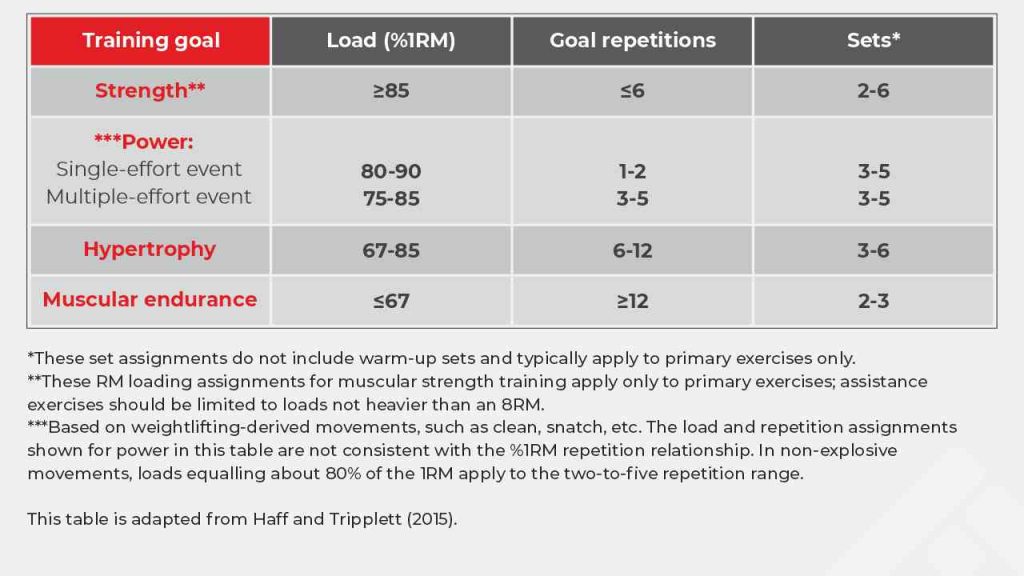
What Are the Ideal Reps and Sets for Your Training Goal(s)?

How do you know if you are doing the correct number of repetitions (reps) and sets for your training goal? Does doing six repetitions per set mean that you are developing strength or hypertrophy? Is there any difference between doing a single set versus multiple sets when training? Here, we attempt to answer some of these questions to guide exercise programming for a variety of training goals.
Understanding commonly used terms
To begin with, here are some important definitions that you need to know before understanding the nitty-gritty of exercise programming:
1. Reps
As mentioned above, it is a short form for repetitions and refers to a single time when weight is lifted; for instance, one bicep curl.
2. Sets
They are either single or multiple repetitions performed in sequence, followed by a short rest interval; for instance, 10 bicep curls, followed by a two-minute rest.
3. Load
It refers to the amount of weight assigned to an exercise set and is probably the most important variable in a resistance training program design. You can determine the training by either some percentage of 1 Repetition Maximum (1RM) or the greatest amount of weight lifted with proper technique for a specified number of reps.
4. Volume
It describes the total amount of work performed within a training session and is typically calculated as either total repetitions (sets x repetitions) or volume-load (sets × repetitions × resistance).
5. Intensity
It refers to ways in which you can monitor the effort of a given workout or set. At times, you may use intensity interchangeably with the load. However, you can also monitor the intensity using the Rating of Perceived Exertion (RPE), heart rate, Repetitions in Reserve (RIR), and velocity scores.
6. Frequency
It is the number of training sessions per week.
7. Recovery
It is the rest period length, usually referring to the amount of inter-set rest, which is rest between sets.
Also read: How Can You Recover From Workouts
Programming for strength, power, hypertrophy (muscle building), or muscle endurance
Depending on the training goal and its modality, which may be resistance-based or aerobically-based, the range of sets and reps will change. The best way to think of the number of sets and reps is to consider the necessary amount of volume to induce adaptation as an ideal range.
Some people with little training experience will be able to achieve a certain level of adaptation at the minimal end of the range. Others, who are more athletic and well-trained, and have been training three to four times per week for more than one year, may achieve adaptation by training at the other end of the range, which indicates higher overall work volumes.
For resistance training, Figure 1 shows how repetition maximum (RM) ranges are associated with various training goals. In addition, Table 1 shows the optimal training loads and the goal number of repetitions and sets needed to accommodate each resistance training goal.

Figure 1. This continuum shows how repetition maximum (RM) ranges are associated with various training goals.

Table 1. Volume assignments based on the training goal.
Programming for weight loss
Muscle building, strength, and neuromuscular power development are key outcomes when undertaking a resistance training program. When it comes to hypertrophy (muscle building), resistance training is more beneficial compared to aerobic training. However, including only resistance training for weight loss may not be enough. There is increasing evidence that aerobic training, coupled with some form of caloric deficit (dieting), is preferable for clinically meaningful weight loss.
Also read: What Is the Science of Weight Loss?
Nevertheless, resistance training may be associated with numerous other health benefits including a reduction in the risk factors of many chronic diseases, a rise in fat-free mass, and a decline in fat mass.
As such, a balanced training program comprising aerobic and resistance-based activities, in conjunction with caloric deficits, may prove to be the best approach to encouraging weight loss while improving various health outcomes
With this in mind, weight training using moderate loads and higher set and repetition numbers may yield higher metabolic stresses. This may prove useful if your ultimate objective is weight loss, which involves raising your basal metabolic rate (BMR).
Selecting volumes based on the exercise order
Exercise order refers to a sequence of resistance exercises performed during one training session. It is advisable to perform power exercises, such as Olympic-based movements including the snatch, hang clean, power clean, and push jerk first in a training session, followed by other non-power core exercises. Later, you may do assistance exercises.
Core exercises (primary exercises) are those that require large muscles. Some of these workouts include squatting, deadlifting, and bench pressing. Generally, they are multi-joint movements and are more metabolically fatiguing.
Usually, assistance exercises target a single muscle (or muscle group) and are single-joint driven like bicep curls, tricep push-downs, or leg extensions. The number of reps and sets within a workout will mainly be led by the power and core exercises within the routine, which you should select depending on the training goal(s). Power and core exercises should approximately comprise up to 90% of the total training volume, with the other 10% coming from the assistance exercises.
Now that you have an understanding of the parameters to keep in mind while determining the appropriate number of reps and sets for your training plan, go ahead and train wisely.
References
1. Haff GG, Triplett NT, editors. Essentials of Strength Training and Conditioning, 4th ed. Cham: Human Kinetics, 2016.
2. Obert, J., Pearlman, M., Obert, L., & Chapin, S. (2017). Popular Weight Loss Strategies: a Review of Four Weight Loss Techniques. Curr Gastroenterol Rep 2017; 19: 61.
3. Grgic, J., Mcllvenna, L. C., Fyfe, J. J., Sabol, F., Bishop, D. J., Schoenfeld, B. J., & Pedisic, Z. (2019). Does Aerobic Training Promote the Same Skeletal Muscle Hypertrophy as Resistance Training? A Systematic Review and Meta-analysis. Sports Med 2019; 49: 233-54.
4. Swift, DL, McGee JE, Earnest CP, et al. The Effects of Exercise and Physical Activity on Weight Loss and Maintenance. Prog Cardiovasc Dis 2018; 61: 206-13.














